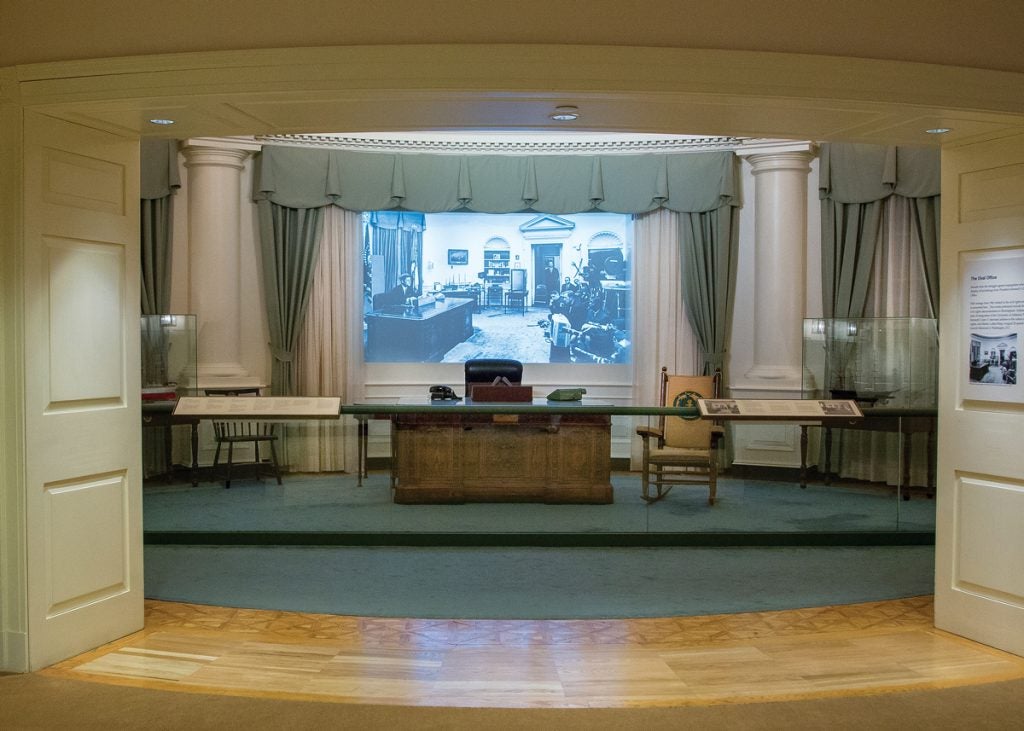
Treasures and tidbits from the library that commemorates a beloved President.
By Tom Kertscher
In July, President Barack Obama signed a law creating the John F. Kennedy Centennial Commission, which is developing activities to remember the youngest man ever elected president. Kennedy, polls have shown, continues to be among the most highly regarded presidents.
When it comes to President John F. Kennedy, the anniversary that is most remembered is his assassination in Dallas on Nov. 22, 1963. But the centennial of his birth fell on May 29, an occasion to honor much more than Kennedy’s death. A URI alumnus is among the few whose job is to preserve the artifacts of Kennedy’s life.
William Bjelf ’08 has worked as the assistant digital archivist for audiovisual collections at the John F. Kennedy Library Foundation in Boston since earning his master’s in library information science. The library’s digital collections include Kennedy’s personal papers and presidential papers. We asked Bjelf about his work.
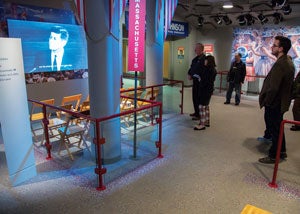
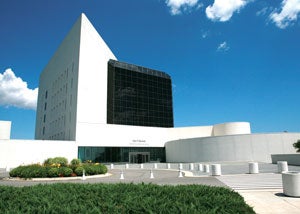
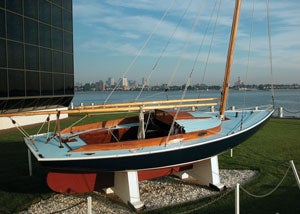
What does your job involve?
I research and help implement standards and best practices for the digitization of photographs, sound recordings, and moving image materials, and for the preservation of digital files. I create and maintain documentation for audiovisual digitization and cataloging workflows, coordinate the digitization of audiovisual assets and catalog digitized audiovisual items.
What are some of the most important contributions you have made in preserving JFK moments?
Preserving collections here is always a team effort. It’s rewarding to learn the best practices for transferring sound and moving image content from analog “carriers,” such as magnetic tape or film, to digital files. The content can be preserved and made available digitally. For those of us who didn’t grow up as audio engineers, it’s very interesting to encounter old analog media and equipment, audio tape reels and cassettes and playback machines, for example, and then to learn the technical parameters required for faithful digital reproduction.
Several years ago, Library colleagues oversaw the digitization of our White House Audio Collection, a collection of recordings of President Kennedy’s speeches and other public remarks. Now I’m helping to preserve our digitized content, including the digital transfers of those historic recordings. President Kennedy’s famous Swearing-in Ceremony and Inaugural Address are part of that collection.
Digitization issues are similar with video and film. For obsolete video sources we need to know some technical details from old television standards. For motion picture film, a few years ago our team began coordinating with vendors to create high definition digital transfers of some materials. We’ve also created workflows for “born digital” recordings. For instance, we’re now accepting donated oral histories recorded digitally for our Returned Peace Corps Volunteers Collection.
What is the favorite piece of JFK material you’ve worked with and why?
Sound recordings of President Kennedy’s telephone conversations have struck me as particularly interesting. These relatively candid moments range from routine to high stakes. For example, President Kennedy’s personal secretary is ordering envelopes in one telephone recording, and in another recording, President Kennedy is discussing rules of engagement for naval vessels during the Cuban Missile Crisis. As you listen along, you sometimes feel as though you’re in the moment.
In our United States Information Agency Audio Recordings Collection, there’s another interesting item, a recording of a Voice of America broadcast of the opening ceremonies of the John F. Kennedy Library Exhibit at the National Archives. In the recording, Dave Powers, who had served as special assistant to Kennedy and later became museum curator of the John F. Kennedy Library, speaks about the exhibit and its reception. He mentions the inclusion of President Kennedy’s desk in the exhibit and recalls a routine involving the desk. In the Oval Office, President Kennedy’s young son, John F. Kennedy Jr., in the morning would hide under the desk and make a noise to get his father’s attention. President Kennedy would ask if there was “a rabbit in there.” His son would then come “busting out,” and President Kennedy would act surprised. During digitization work, we encounter an interesting variety of content.
What about your time at URI helped you succeed in your career?
URI’s information studies program gave me a solid foundation in professional ethics, research and description, and relevant technologies. My internship gave me hands-on experience working in a digitization program. During this internship I saw how an institution approached digital imaging, how it made use of scanners and cameras, particular digital file formats, and automation in parts of its digital asset management system. This experience was crucial for me. •
JFK in R.I.
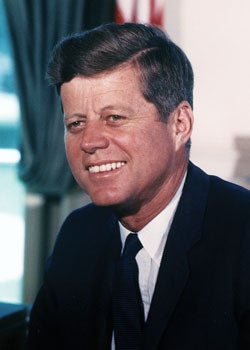
Married Jacqueline Bouvier at St. Mary’s Church in Newport in 1953. The wedding reception was held at Hammersmith Farm.
Spoke at Providence City Hall on Nov. 7, 1960, on the final day of his presidential campaign before defeating Richard Nixon on election day. “Let me make it clear, this campaign is now coming to an end, and tomorrow the respective responsibilities of Mr. Nixon and myself cease and yours begin,” he said.
Became on June 7, 1961, the first president since Teddy Roosevelt to speak at the U.S. Naval War College in Newport. “I know that you are constantly warned during your days here not to mix, in your Naval career, in politics,” he said. “I should point out, however, on the other side, that my rather rapid rise from a Reserve Lieutenant, of uncertain standing, to Commander-in-Chief, has been because I did not follow that very good advice.”
 Home
Home Browse
Browse Close
Close Events
Events Maps
Maps Email
Email Brightspace
Brightspace eCampus
eCampus



